《THE DIPLOMAT》
China's Potential Pitfalls #1: The Environment
“Environmental pollution is the great challenge that China must face during its next stage of development.”
By Xue Li
November 10, 2015
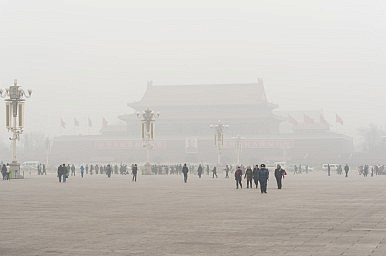
Image Credit:
After enjoying rapid development for nearly 40 years, China is at a turning point in terms of both economic growth and social development. In this series, Dr. Xue Li examines the five most critical challenges and potential pitfalls China faces today.
Environmental pollution is the great challenge that China must face during its next stage of development. Everyone has gradually come to realize this, though some local governments persist in taking the view that development must have top priority. Other localities however, are already willing to sacrifice some economic development for the sake of the environment. Even some of China’s less-developed regions are consciously choosing low-pollution means of economic development.
From the experience of developed countries, we know that remediating pollution problems and restoring the environment is possible but expensive. That means China’s environmental problems, to an extent, can only be solved by further economic development.
Although China’s economy has seen a long-term period of rapid growth, the process of industrialization is still incomplete, while urbanization has even further to go. Thus China’s overall energy consumption as well as its per capita energy use are both rising. Yet China has already pledged that its carbon dioxide emissions will peak by 2030, with a concerted effort toward reaching peak emissions even sooner. Also by 2030, China plans to have non-fossil fuels account for 20 percent of its total energy use (in 2013, non-fossil fuels made up 9.6 percent of China’s energy use).
This makes it clear that the Chinese government has already realized that, although adjusting the makeup of its energy consumption is difficult, it must be done. But because there still isn’t enough recognition of the problem – and because of entangled bureaucratic interests – China still must take further steps to strengthen the implementation of these changes to its energy matrix.
First, China must be firm and resolute in its determination to lower the proportion of coal in China’s total energy consumption. China must lower the proportion of coal from 67.5 percent of China’s total energy use in 2013 to less than 40 percent, and the sooner the better – by 2030 at the latest. China is already the world’s largest emitter of greenhouse gases, and accounts for over half of global coal consumption. Coal is a carbon-intensive source of energy; the current measures to clean up coal (such as the coal chemical industry) are only diverting the pollution problem. Meanwhile, carbon sequestration, through helpful in reducing pollution, is prohibitively expensive (and has its own hidden costs).
The main reason is it so difficult to reduce the proportion of coal is that coal is so cheap. But this doesn’t take into account the costs of environmental pollution, and the harm caused to human health. China should realize that, if it hopes to significantly reduce environmental pollution caused by energy use and realistically achieve the goal of sustainable development, reducing coal use is the best choice.
What can China use to replace coal? I’ve researched this topic before, and there are a number of possibilities: natural gas being the most promising, followed by nuclear power, then hydropower, wind power, solar power, and bioenergy.
Of all the fossil fuels, natural gas is the best choice – obviously better than coal, but also preferable to oil. The proportion of natural gas in China’s energy consumption should rise from 5.1 percent in 2013 to 30 percent or higher, surpassing oil (which accounted for 17.8 percent of energy consumption in 2013). Nuclear energy, meanwhile, should rise from 0.9 percent to 10 percent or more of China’s total energy use. Many people oppose nuclear energy use, but the undeniable fact is that after a comprehensive look at the technological level required, environmental protection concerns, safety, and economic factors, nuclear power is second only to natural gas as an energy choice.
Hydropower is clean energy, but it already accounts for 7.2 percent of China’s total energy consumption; there’s no room for more large-scale growth. Currently, wind, solar, and bioenergy sources combined account for only 1.5 percent of China’s energy use. For a high-energy using country like China, it will be hard to use these three as primary energy sources, but bioenergy has the greatest long-term potential for development.
The next potential pitfall: China’s political and economic models
Dr. Xue Li is Director of the Department of International Strategy at the Institute of World Economics and Politics, Chinese Academy of Social Sciences. Translation courtesy of Gao Dawei.
China's Potential Pitfalls #2: The Limitations of China’s Political and Economic Models
30 years since beginning its reforms, China has yet to create a political and social model for sustainable development.
By Xue Li
November 11, 2015
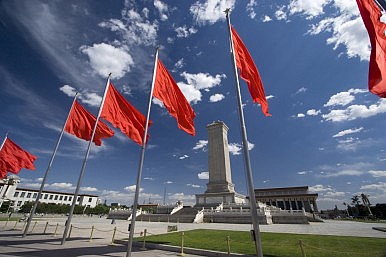
Image Credit:
After enjoying rapid development for nearly 40 years, China is at a turning point in terms of both economic growth and social development. In this series, Dr. Xue Li examines the five most critical challenges and potential pitfalls China faces today. See the first piece here.
More than 30 years have passed since China began its reform and opening up, but it has yet to create a political and social model for sustainable development.
On the economic side, by and large the market economy has taken the leading role, but there are some serious shortcomings. The government still intervenes too much in the economy. This problem of improper intervention in the economy has not been solved. To cite just two examples:
First, the stock market bears clear signs of being a policy-driven market. The recent classic example is the government’s violent intervention to rescue the market Regrettably, not only was this action ineffective, it also provided evidence to those abroad who doubt that China has a market economy. Fortunately, the government has taken note of that and is making suitable adjustments. This new recalibration very possibly will suit the needs of a market economy.
Second, restrictions on and discrimination against private sector enterprises remains a problem. Private sector enterprises already provide employment for most of China’s labor force and account for most of China’s GDP. However, many fields restrict or forbid the entry of private enterprises. The proportion of state-owned enterprises (SOEs) is too large. SOEs are less efficient and yet still often get special treatment, such as being granted monopoly status or special subsidies. This leads to unfair market conditions and to the waste and reverse flows of economic resources.
Politically, leaders at every level of China’s government have too much overall influence on the area which they govern. A change in leaders brings on a cascade of new policies — big changes in planning for economic development, in urban construction and planning, and in the bureaucratic system. Meanwhile, the problem of inadequate oversight of the top leaders at each level has not been solved. Plus, there is no mechanism for effectively constraining the growth of local debt. According to European and U.S. standards, some Chinese local governments are in fact already bankrupt.
China’s Social Stability: Political and Economic Factors
Over the past 30-plus years, several factors have made it possible for China to maintain its overall social stability. For one thing, an enormous amount of capital has been expended on maintaining social stability. However, China faces constraints how much it can increase and intensify spending on social stability. Social stability expenses already exceed military spending and there is limited room for further increases.
Another factor in China’s social stability is that officials have co-opted political, economic, and cultural elites. Political elites are given status as members of the People’s Congress or as members of the Political Consultative Congress and invited to join government leaders’ delegations visiting foreign countries. Economic elites are allowed to join the Party and even enjoy special permissions and support for their commercial activities (Geely’s purchase of Volvo is a classic example). In the academic world, elites get opportunities to participate in politics, planning, and policymaking, and thereby earn a comfortable income. Most people, and particularly elites, fear chaos. Once these elites have been co-opted into the government system through the means listed above, they generally support it.
However, the most important factor in keeping China’s social stability has been the political legitimacy that economic growth has brought with it (what we might call GDP-based legitimacy). But economic growth has a cyclical character. The Chinese economy, which has already grown rapidly for several decades, will at some point change to low growth, zero growth, or even negative growth. All this would be normal. But if there are economic issues, then there will also be political issues.
Dramatically slowed growth will create many different chain reactions in China, both from society at large (such as more mass incidents) and from within the Party. The case of the Soviet Union shows that some party cadres from rich families are always looking for opportunities to legalize and become open about their personal fortunes. This kind of attitude — that the misfortune of the country is an individual cadre’s good fortune — under certain circumstances becomes a threat to state stability. There could also be threats from outside the mainland, if the United States or even Taiwan decides to take advantage of China’s slowing growth.
DrChina's Potential Pitfalls #3: Core Values. Xue Li is Director of the Department of International Strategy at the Institute of World Economics and Politics, Chinese Academy of Social Sciences. Translation courtesy of Gao Dawei.
China's Potential Pitfalls #3: Core Values
“China’s society has become sick and needs treatment.”
By Xue Li
November 12, 2015
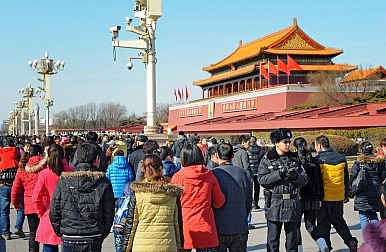
Image Credit:
After enjoying rapid development for nearly 40 years, China is at a turning point in terms of both economic growth and social development. In this series, Dr. Xue Li examines the five most critical challenges and potential pitfalls China faces today. See his previous pieces on Pitfall #1 and Pitfall #2 as well.
China lacks core values – values that are widely believed in by both officials and the people and reflected in their actions. Core values can also be understood as a system of cultural and political beliefs.
In place of core values, we see the ‘religion’ of worshiping money and material things widely manifested in China. As an example, when Chinese people make pilgrimages to temples throughout the country, they often throw coins to supplement their requests. We see piles of coins on the back of dragons, on the feet of Buddha, and thrown into pools. These sparkling coins are reflected in popular sayings such as “If you have money you can gets ghosts to act” and “Celestial beings can also be bribed.”
It is understandable that such a phenomenon might appear at a certain stage in the commodity economy, but it is not normal. It reflects the lack of religious belief among the people and the rule of the religion of worship of money and material things superimposed on the pragmatic psychology of the Chinese people.
Core values go beyond religion, of course – they reflect the cultural characteristics of a group of people. These are the sources of the group’s cohesiveness. Politically, core values are the source of the state identity. For a multiethnic state, this has political implications: the absence of support for a set of core values will affect the stability and even existence of the state. Such a state would lack a solid foundation for its development and rise. Therefore, establishing a shared system of cultural and political beliefs is a fundamental problem that China needs to solve.
Thanks to this lack of core values, there are two social and cultural phenomena worthy of note in China today. The first is that people have a general feeling of dissatisfaction. No matter whether we are talking about leftists, moderates, or rightists; activists, advocates of the status quo, or conservatives; high-ranking cadres, mid-level leaders, grassroots cadres; the wealthy, the middle class, or the poor – nearly everyone is dissatisfied with the present state of society and with their own personal situation. Many people even hate the rich and hate officials.
The second phenomenon is a general feeling of insecurity. Officials, owners of small and medium sized enterprises, scholars – especially those intellectuals in the humanities and in the social sciences – workers, migrant workers, and peasants all feel insecure, though for different reasons. Some feel insecure about their property, some about their official position, and some because of the views that they have expressed and still others because of their health insurance. Still others feel insecure about the prospects for their businesses, and others feel insecure about their right to reside in a big city and the related problem of their children’s right to an education in that city. Some feel insecure about their lands, which they have cultivation rights to under the contract responsibility system.
How do people handle this insecurity? Some officials or wealthy businessmen transfer their property and send their wives and children abroad. Some entrepreneurs register their companies outside the mainland. Some peasants focus on maximizing their short-term gains by exploiting the land that they work under the contract responsibility system. These are all manifestations of feelings of insecurity, and most people are familiar with these issues.
What few people understand are the insecurities of the middle class in China’s big cities, especially in Beijing and Shanghai. Typically, these people have been working hard in the big city for ten-odd years; they have a home and children. They no longer fit in to their old homes in the countryside. They have already become city people – except for the problem of city resident household registration (a hukou). Suddenly one day they find that their child, because of the hukou problem, can’t get into a good local primary school or lower middle school. Even worse, their child can’t attend a local high school and so must return to their old home to take the high school entrance examination.
These families face a difficult choice: they can give up their jobs in the city and have the whole family return to their former home for several years; the husband and wife can live apart while one returns to their former residence with the child; or they can send the child back to their former home, alone, to study. The alternative is for the child to settle for a mediocre high school in the city and then takes the examination for a technical vocational school, giving up on higher education. Any choice they make will have serious consequences.
These families feel deeply conflicted. You can just imagine the dissatisfaction; the feelings of insecurity and even anger that this leads to. These people are relatively small in number, but they are symbolic. They are the touchstone of China’s urbanization and the foundation of China’s social stability.
This level of dissatisfaction and insecurity did not exist in the 1980s. These issues became apparent in the 1990s and have now become serious. This means that China’s society has become sick and needs treatment. Many people say that these are development problems – they arise during a period of development and can only be solved by further economic growth. But the issue of core values will not be fixed by economic development.
Dr. Xue Li is Director of the Department of International Strategy at the Institute of World Economics and Politics, Chinese Academy of Social Sciences. Translation courtesy of Gao Dawei.
China's Potential Pitfalls #4: Splittist Forces
How separatists in Tibet, Xinjiang, and Taiwan could affect China’s future.
By Xue Li
November 13, 2015
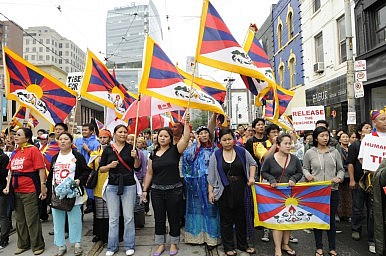
Image Credit:
After enjoying rapid development for nearly 40 years, China is at a turning point in terms of both economic growth and social development. In this series, Dr. Xue Li examines the five most critical challenges and potential pitfalls China faces today. See his previous pieces on Pitfall #1, Pitfall #2, and Pitfall #3 as well.
China’s problem with splittist forces is related to the issue of core values, but it is not completely the same thing. China has two kinds of splittist forces: splittist forces in mainland China (i.e. advocates for “Xinjiang independence” and “Tibet independence”) and Taiwan splittist forces (Taiwan independence). Let’s look at each of these issues briefly:
When it comes to “Tibet independence,” we perhaps should seize the moment and start negotiations with the Dalai Lama. This would be to China’s advantage since the Dalai Lama and the Chinese government have a long history of interaction spanning decades. They understand each other fairly well. The Dalai Lama’s views are more moderate compared with the younger generation. For example, the Dalai Lama has not openly supported independence. But he is already 80 years old so time is running out.
The Xinjiang issue is more complicated, as we will see. The Chinese government has, for several years, taken a multi-pronged approach to “Xinjiang independence.” The government has resolutely attacked “Xinjiang independence” forces and actions; it has developed a “group defense and group solution” that aims to destroy even the first sprouts of Xinjiang separatism. The government has strengthened border controls to prevent “Xinjiang independence” forces from fleeing across the border while at the same time taking measures to facilitate the entry and exit of ordinary citizens. The government has invested in economic development in order to weaken the economic factors that favor the rise of the “three forces” — religious extremism, ethnic splittism, and violent terrorism.
The problem confronting us today is that the “three forces” are spreading outside Xinjiang to other Chinese provinces as well as beyond China’s borders. However, the real threat to the long range stability and development of Xinjiang is religious extremism. Religious extremists infiltrate the ethnic culture of the Uyghurs, thereby influencing the daily lives and worldview of ordinary people. They plot in this way to weaken local governments.
Finally, “Taiwan independence” is certainly a challenge. During Ma Ying-jeou’s time in office, cross-strait relations were relatively stable and economic ties strengthened. However Ma’s successor will very possibly be Tsai Ing-wen. Her spiritual leader is former President Lee Teng-hui, who has a reputation as a “Taiwan independence” advocate. In 1999, Lee even proposed the idea of “special state-to-state relations” to govern cross-strait relations. Tsai, as a council member, contributed to planning on the National Security Council and National Reunification Council. Then, in 2002, President Chen Shui-bian in 2002 proposed the idea of “a country on each side of the Taiwan Strait” and Tsai, as chair of the Mainland Affairs Council, made important contributions.
Tsai is a knowledgeable person, a strategic thinker who believes in “Taiwan independence” who will certainly show that she is inferior to none of her male colleagues. We should not lightly assume that she has changed her political views because of words spoken during an election campaign. Any move toward Taiwan independence would cross the mainland’s red line and could spark military action — which would severely damage China’s foreign trade and economic situation.
Dr. Xue Li is Director of the Department of International Strategy at the Institute of World Economics and Politics, Chinese Academy of Social Sciences. Translation courtesy of Gao Dawei.
China's Potential Pitfalls #5: The United States
U.S. China policy remains a challenge for Beijing, but it’s not the South China Sea that will cause major issues.
By Xue Li
November 14, 2015
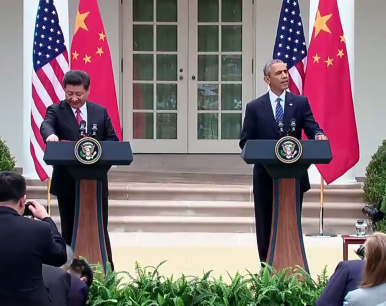
Image Credit:
After enjoying rapid development for nearly 40 years, China is at a turning point in terms of both economic growth and social development. In this series, Dr. Xue Li examines the five most critical challenges and potential pitfalls China faces today. See his previous pieces on Pitfall #1, Pitfall #2, Pitfall #3, and Pitfall #4 as well.
China’s final potential pitfall is the foreign threat, which comes principally from the United States. Westernizing China remains the long-term goal of the United States, and the medium-term goal of dragging China into the current world order is also a westernization tactic.
Over the short term, Americans are working hard to establish win-win cooperation with China. But if China should fall into difficulties, the U.S. will adjust its policy goals. If economic stagnation and mass social unrest should appear in China, the forces aiming to divide the mainland will grow stronger, and those in the U.S. who want to westernize China (and fundamentally obliterate China’s capacity to challenge the United States) will see their goals as more realistic.
Ever since China began its reform and opening policy, the principal strategy of the United States has been engagement first and hedging second. Since 2014, however, this has been trending toward hedging first and engagement second. As hedging becomes more important, the South China Sea issue is now the touchstone for the United States in its monitoring of trends in Chinese foreign policy. Meanwhile, the U.S. has become more and more directly involved in the South China Sea issue. It is now one of the main players.
However, the principal goal of the United States in acting this way is not to contain China (as it contained the Soviet Union during the Cold War), but instead to maintain the regional balance of power, maintain regional stability, and to protect its interests. In order to do this, the U.S. needs to have a fairly clear understanding of China’s policy goals in the South China Sea. Therefore the U.S. finds it hard to accept China’s ambiguous policies. However, the South China Sea is not a core interest of the United States and so it is unlikely to fight a war with China over the South China Sea.
In fact, neither China nor the United States have any intention of fighting a war in the South China Sea. The disagreement about the South China Sea is actually being controlled effectively by both sides. China is also adjusting its own South China Sea policy in order to facilitate the accomplishment of its “21st Century Maritime Silk Road” strategy. China and the United States need to maintain communication about the South China Sea issue so that they will be able to reach more understandings and to avoid miscalculations.
If China is able to successfully respond to the five challenges I’ve listed in this series, it will not stumble on the threshold of becoming a developed country. China could continue to develop until it becomes the most powerful country in the world — this is the goal of the Chinese renaissance. However, if China is not able to respond effectively, these challenges could become pitfalls on the road to China’s rise.
Dr. Xue Li is Director of the Department of International Strategy at the Institute of World Economics and Politics, Chinese Academy of Social Sciences. Translation courtesy of Gao Dawei.